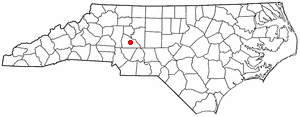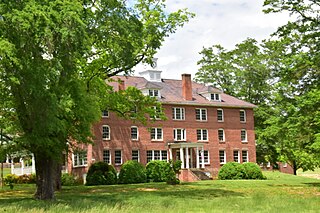
Granite Quarry is a town in Rowan County, North Carolina, United States. The population was 2,984 at the 2020 census.

Mount Airy is a city within Surry County, in the U.S. state of North Carolina. As of the 2020 United States census, the city's population was 10,676, an increase of 288 (+2.8%) from the 2010 census count of 10,388. As of 2020, the city is the most populous municipality in Surry County. Mount Airy is located within the Piedmont Triad metropolitan region.

The Colorado State Capitol Building, located at 200 East Colfax Avenue in Denver, Colorado, United States, is the home of the Colorado General Assembly and the offices of the Governor of Colorado, Lieutenant Governor of Colorado, and the Colorado State Treasurer.

Wright Brothers National Memorial, located in Kill Devil Hills, North Carolina, commemorates the first successful, sustained, powered flights in a heavier-than-air machine. From 1900 to 1903, Wilbur and Orville Wright came here from Dayton, Ohio, based on information from the U.S. Weather Bureau about the area's steady winds. They also valued the privacy provided by this location, which in the early twentieth century was remote from major population centers.
Mount Waldo is a small mountain about 1,060 feet (320 m) high in Waldo County, Maine. It is located in the town of Frankfort.

The Moses H. Cone Memorial Park is a country estate in honor of Moses H. Cone in Blowing Rock, North Carolina. It is on the Blue Ridge Parkway between mileposts 292 and 295 with access at milepost 294. Most locals call it Cone Park. The park is run by the National Park Service and is open to the public. It contains 3,500 acres (14 km2), a 16-acre (65,000 m2) trout lake, a 22-acre (89,000 m2) Bass Lake and 25 miles (40 km) of carriage trails for hiking and horses. The main feature of the park is a twenty-three room 13,000-square-foot (1,200 m2) mansion called Flat Top Manor built around the early 1900s. At the manor, there is a craft shop and demonstration center, along with an information desk and book store.

The U.S. Custom House or U.S. Customhouse is the custom house in Charleston, South Carolina. Construction began in 1852, but was interrupted in 1859 due to costs and the possibility of South Carolina's secession from the Union. After the Civil War, construction was restarted in 1870 and completed in 1879. The building was placed on the National Register of Historic Places on October 9, 1974. It is also a contributing property of the Charleston Historic District.

The Guglielmo Marconi Memorial is a public artwork by Attilio Piccirilli, located at the intersection of 16th and Lamont Streets NW in the Mount Pleasant neighborhood of Washington, D.C. It stands as a tribute to Italian inventor Guglielmo Marconi, whose work with telegraphy and radio waves led to the creation and popularity of the radio. It was paid for by public subscription and erected in 1941. The artwork was listed on both the District of Columbia Inventory of Historic Sites and the National Register of Historic Places in 2007. It is a contributing property to the Mount Pleasant Historic District.

The outdoor statue of Benjamin Franklin in Washington, D.C., is located near the intersection of 12th Street and Pennsylvania Avenue NW, in front of the Old Post Office. The statue was a gift from Stilson Hutchins, founder of The Washington Post, who wanted to display his and the newspaper's stature in the city. The designer, Ernst Plassmann, and sculptor, Jacques Jouvenal, were both German-American artists. The architect of the memorial was J. F. Manning.

The Darlington Memorial Fountain, also known as the Joseph Darlington Fountain, Nymph and Fawn, and Darlington Fountain, is a sculpture by C. Paul Jennewein atop a fountain in honor of Joseph James Darlington. It is located at Judiciary Park, where 5th Street, D Street, and Indiana Avenue NW intersect in the Judiciary Square neighborhood of Washington, D.C. The fountain is surrounded on three sides by government buildings, including the United States Court of Military Appeals, the H. Carl Moultrie Courthouse, and the former District of Columbia City Hall.

The Barre Downtown Historic District encompasses the historic commercial and civic heart of the city of Barre, Vermont. Extending along Main Street from City Park to Depot Square, this area was developed quite rapidly in the 1880s and 1890s, when the area experienced rapid growth due to the expansion of the nearby granite quarries. It was listed on the National Register of Historic Places in 1979.
Leslie N. Boney Sr. (1880–1964) was an American architect who focused on schools. He designed approximately 1,000 schools or additions to schools, and his works appear in 51 of North Carolina's 100 counties.

Professor Joseph Henry, also known as the Joseph Henry Memorial, is an outdoor bronze sculpture depicting scientist Joseph Henry, the first president of the Smithsonian Institution. The statue stands in front of the Smithsonian Institution Building in Washington, D.C., facing the National Mall. It was sculpted by artist William Wetmore Story, and dedicated in 1883, a few years after Henry's death. The bronze statue and granite base were unveiled in front of thousands of onlookers and invited guests. Speeches at the dedication included one from Chief Justice of the Supreme Court Morrison Waite, and the president of Yale College, Noah Porter.

The American Tobacco Historic District is a historic tobacco factory complex and national historic district located in Durham, Durham County, North Carolina. The district encompasses 14 contributing buildings and three contributing structures built by the American Tobacco Company and its predecessors and successors from 1874 to the 1950s. Located in the district is the separately listed Italianate style W. T. Blackwell and Company building. Other notable contributing resources are the Romanesque Revival style Hill Warehouse (1900), Washington Warehouse (1902–07), the Lucky Strike Building (1901–02), and Reed Warehouse; Noell Building ; Power Plant and Engine House (1929–39); and the Art Moderne style Fowler (1939) Strickland (1946) and Crowe (1953) buildings.

Rockton and Rion Railroad Historic District is a national historic district located near Winnsboro, Fairfield County, South Carolina, United States. The district encompasses forty contributing buildings, six contributing structures, and two contributing objects associated with the quarrying, finishing, and transporting of Winnsboro blue granite. The district resources were built between about 1883 and about 1945.

Patterson School Historic District is a historic agricultural and Episcopal mission school complex and national historic district located at Legerwood, Caldwell County, North Carolina. The complex includes 13 contributing buildings, 2 contributing sites, and 3 contributing structures. Notable contributing resources include the Colonial Revival-style Palmyra Hall (1927), Sarah Joyce Lenoir Memorial Library, Gard Hall (1920-1921), Headmaster's House (1912), Buffalo Creek Dam (pre-1940), Milk House (1945), two Barns, North Silo (1920s), Chapel of Rest (1918), Jones-Patterson Cemetery, Hugh A. Dobbin House, and Tudor Revival-style Edgar A. Dobbin House (Greystone) (1930s). In 1994 the Episcopal Diocese of Western North Carolina sold the Patterson School property.

Washington Park Historic District, also known as the Southside Neighborhood, is a national historic district located at Winston-Salem, Forsyth County, North Carolina. The district encompasses 348 contributing buildings, 1 contributing site, and 2 contributing structures, in a predominantly residential section of Winston-Salem. It was a planned speculative development centered on a streetcar line. The buildings date from about 1892 to 1940, and include notable examples of Colonial Revival, Queen Anne, and Bungalow / American Craftsman style architecture. Notable buildings include the Schlatter Memorial Reformed Church (1916).
Granite Quarry School, also known as Schuford Memorial Elementary School and Granite Quarry Elementary School, is a historic school complex located at Granite Quarry, Rowan County, North Carolina. The main school building was built in 1933, and is a one-story, H-shaped building sheathed in granite. It has a side-gable roof with shed dormers and a pedimented entrance portico. Connected to the main building by open, covered walkways are the cafeteria (1956) designed by Leslie Boney and a classroom building (1960). It was originally built for African-American students and continued to operate until 1968 when its students were integrated into other county schools.
Salisbury Historic District is a national historic district located at Salisbury, Rowan County, North Carolina. The district encompasses 348 contributing buildings and 1 contributing site in the central business district and surrounding residential sections of Salisbury. It includes notable examples of Late Victorian, Colonial Revival, and Bungalow / American Craftsman style architecture. Located in the district are the separately listed Maxwell Chambers House, McNeely-Strachan House, Archibald Henderson Law Office, and the former Rowan County Courthouse. Other notable buildings include the tower of the former First Presbyterian Church (1891-1893), Rowan County Courthouse (1914), Conrad Brem House, Kluttz's Drug Store, Bell Building, Washington Building, Grubb-Wallace Building, Hedrick Block, Empire Hotel, St. Luke's Episcopal Church (1827-1828), Soldiers Memorial A.M.E. Zion Church (1910-1913), U.S. Post Office and Courthouse (1909), City Hall (1926), Salisbury Fire House and City Building (1897).


















